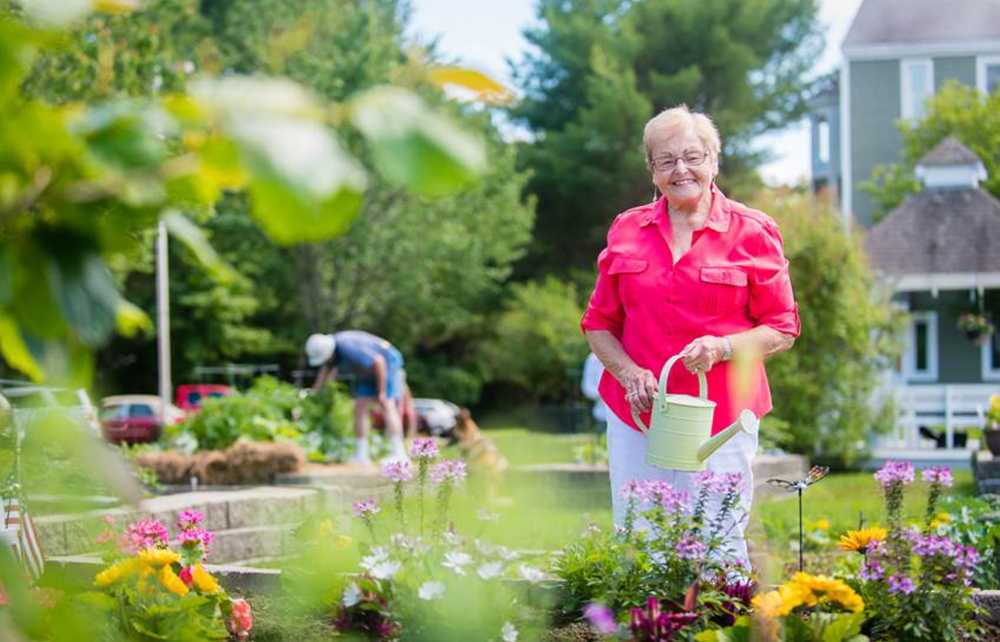People who have gardened for decades are not going to stop gardening voluntarily – even if they move to a retirement community.
At least two retirement communities in southern Maine – The Highlands in Topsham and Ocean View in Falmouth – have raised beds that residents can treat as their own, growing flowers, vegetables or both.
In addition, people who own stand-alone homes in the retirement communities can garden just the same as any homeowner.
The Highlands and Ocean View are continuing-care retirement communities, which include stand-alone houses and apartments for independent living; assisted living units; a nursing home; and a memory care section.
The independent-living residents account for most of the gardeners at The Highlands and Ocean View – although some independent residents at both places volunteer to garden with people who require more care, as a kind of gardening therapy.
The Highlands has 15 raised beds, each measuring about 6 by 12 feet and all located in one area.
“It is so important for seniors to maintain something that was such a fulfilling part of their life before they came here,” said director of life enrichment Crystal Toothaker, who oversees the beds. At the moment, there is no waiting list, she said, although if more than 15 residents wanted to garden, some would share a plot.
Irma Konecny said she used to grow flowers at her own home. When she moved to The Highlands, where she has a nearby son who loves to cook, she began growing corn, peas, tomatoes and other vegetables for him. But she also grows flowers.
Next year, The Highlands is planning to create a community plot, Toothaker said, so residents can grow food to donate to the Midcoast Hunger Prevention Program.
At Ocean View, the raised beds – about 20 in all – are placed wherever there is space and sun. Some residents share beds, which are about 4 by 10 feet.
Dawn Wheeler, director of activities and events, and three avid-gardening residents – Glenn Wildes, Margaret Cope and Sally Heald – gave me a tour recently.
“I fully expected to move here and not be able to garden,” Cope said. As it turns out, in addition to having one of the beds, Cope is able to grow vegetables and flowers on the deck of her second-floor apartment; she was especially proud of the cucumber she had produced in early August.
Wildes has gardened “forever.” When he moved to Ocean View, he even brought with him a tractor that was used in World War II Victory Gardens (it’s now a decorative element).
Even the residents who don’t garden themselves enjoy looking at the gardens, Wildes said. And non-gardening residents can take tours of the gardens.
At both Ocean View and The Highlands, the staff creates and fertilizes the soil in the beds at the beginning of the season. After that, it’s up to the gardeners.
Although Cope is pleased with her raised bed and the plants she grows on her deck, she doesn’t consider the Ocean View gardens a true community garden – which usually have more beds in one place and hold organized programs. She said Kendal at Hanover, a continuing care retirement community in New Hampshire, has a true community garden.
Virginia Rolett, a Kendal resident who is on the committee that runs the community garden there, said in a telephone interview that the place has 30 ground-level 10-by-10-foot plots surrounded by an electric fence to keep critters out. On Fridays during growing season, Kendal holds a farmers market for staff and residents, with proceeds going to the residents association.
“Kendal is a nonprofit basically run by the residents,” Rolett said, a fact she credits for its large community garden. “We don’t have a corporation that tells us what we can and can’t do.”
(Because Ocean View is built on ledge, Wheeler said a large, in-ground community garden is probably unrealistic.)
Both Ocean View and The Highlands let residents – with permission – garden outside the raised beds, too. One Highlands resident planted 100 gladioli in a prime spot. Another prunes the shrubs, Toothaker said.
In an area where Ocean View is expanding, Wildes planted daylilies and irises and more than 100 daffodil bulbs. He says he enjoys the work and looks forward to the blooms.
Many communities for the elderly – whether assisted living, nursing or memory care – use gardens to provide therapy for the residents. While viewing, smelling and touching beautiful plants is therapeutic, it is even more therapeutic to grow those plants.
Tom Atwell has been writing the Maine Gardener column since 2004. He can be contacted at 767-2297 or at tomatwell@me.com.
Send questions/comments to the editors.



Comments are no longer available on this story